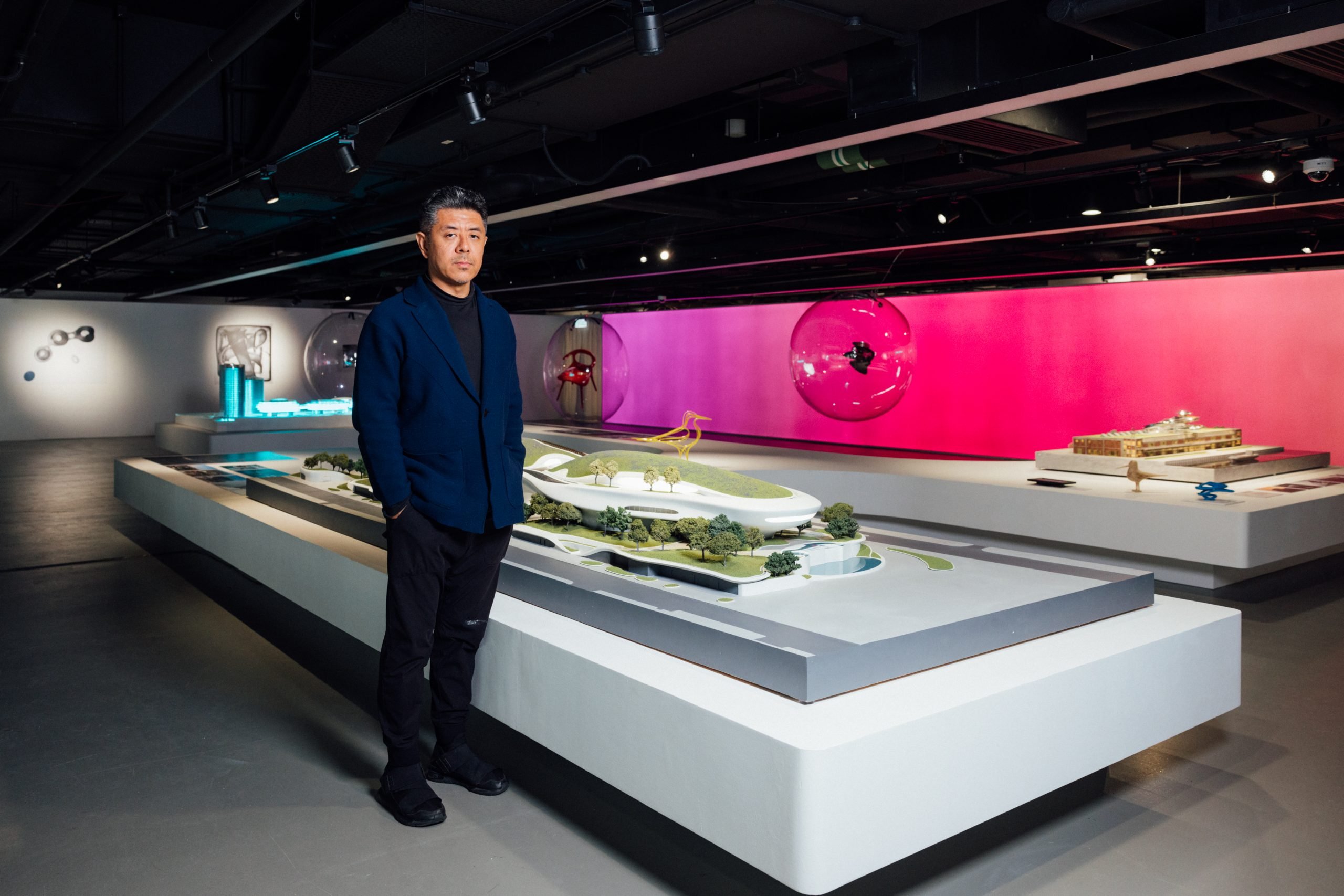
Chinese architect Ma Yansong founded MAD Architects in 2004, and was awarded the Young Architects Award by the Architectural League of New York in 2006. Holding a BA in engineering and architecture from the Beijing Institute of Civil Engineering and Architectures, as well as MA in architecture from Yale University, Ma’s work is recognized for referencing natural and organic forms and taking a people-first approach to building and site design.
On view through April 7, 2024, HKDI Gallery of the Hong Kong Design Institute is presenting the solo exhibition “Ma Yansong: Landscapes in Motion,” one of the gallery’s flagship design showcases. The show is a continuation and adaptation of a 2023 exhibition of Ma’s work held at the Shenzhen Museum of Contemporary Art and Urban Planning. At HKDI Gallery, the show was exclusively curated by Ma himself, offering new avenues of work presentation and the precise execution of his vision. In addition to featuring a range of Ma’s most significant urban architectural projects, it also offers a glimpse into Ma’s more experimental concepts as well as unrealized projects.
Taking place concurrently with Hong Kong’s Art Month, we caught up with Ma to learn more about how the exhibition was brought to life, and what he sees as the future of architecture and design.
Installation view of “Ma Yonsong: Landscapes in Motion” (2024). Courtesy of HKDI Gallery, Hong Kong.
Can you tell us a bit about the themes and ideas featured in your solo exhibition, “Ma Yansong: Landscapes in Motion,” at HKDI Gallery?
My practices often emphasize incorporating nature as a means of reinterpreting modern urban environments. Mostly using fluid forms, the goal is to create spaces that connect to people spiritually and emotionally. Architecture both stands for a long time span; it also could be seen as in motion through design. Therefore, the exhibition is titled “Landscapes in Motion.”
Can you walk us through what went into curating this project? Where did you start, and did anything change or surprise you along the way?
The first stop of this exhibition was in Shenzhen. We didn’t have an external curator, but took this as an opportunity for an introspective journey to make a comprehensive review of our own work from the past 20 years. It was a very interesting journey. Shenzhen has an exhibition space on a huge scale. We made certain visual adaptions, but kept the same tune setting for HKDI Gallery. And also added more content such as drawings, diagrams, and videos for educational purposes.
Ma Yansong, model for FENIX Museum of Migration, Rotterdam, Netherlands (2018–2025). Courtesy of HKDI Gallery, Hong Kong.
How would you describe your design philosophy? Where do you most frequently look for or find inspiration?
I have strong feelings about what I’m against—boredom, inequality, thoughtlessness, illiberal, etc. Those qualities that lead to a possibly dimmed, inhumane, or uninformed future. This gradually formed my design philosophy and added to my admiration for nature. People say of my design: the boundary between architecture and art is very blurred. The objections I have above turn into bold, futuristic languages in my design. And that is why we are called “mad.”
I don’t usually have one source of inspiration that can be pointed to. Movies, books, conversations, and places I travel, these can all be inspirational. As long as we architects don’t stop thinking.
What do you hope visitors to the exhibition take away with them?
I hope that the students and visitors can see the diversified future that is possible through urban development. I also hope to start a conversation with visitors about the relationship between high-density cities and nature, public space, and people, and that my work stimulates them into thinking about different futures.
Ma Yansong, model for Quzhou Sports Park, Quzhou, China (2018–2025). Courtesy of HKDI Gallery, Hong Kong.
What do you see as the role of contemporary design in the world today?
If you put Modernism in the long history of human civilizations, it seems to be fleeting. Sometime I feel like we are stuck between the future and the past. That not all design can lead us to a prosperous future or even build a civilization that belongs to this era. We should think about what design we are creating and how, after centuries, future generations will look at us.
The boundaries between media, design, and art are increasingly blurred. Design is undoubtedly a main force shaping our current culture. It reaches greater audiences and is more connected to people’s daily life. Instead of focusing only on resolving problems, we also need to raise questions philosophically about what shall be done now to shape a different future. The concept itself is as important as the result.
Are there any trends or changes within the design world today that you find particularly interesting or exciting?
Artificial intelligence presents an exciting advancement that release people from mundane tasks, so they may focus on more creative work. Also, I’m curious about all the anti-gravity technological innovations. Space travel, and also travel methods on earth. It’s been a long time since there has been a change in modern transportation, which has somewhat imprisoned the growth of cities and the integration of global civilization. Our cities will be so different if we revolutionize transportation methods, and our current civilization can take a big step forward.
Ma Yansong, model for Lucas Museum of Narrative Art, Los Angeles, CA (2014–2025). Courtesy of HKDI Gallery, Hong Kong.
Can you tell us about what you are working on now, or are planning to work on next?
This year is an important year for MAD Architects with several important projects due to be completed, including Shenzhen Bay Cultural Plaza, Lucas Museum of Narrative Art, and FENIX Museum of Migration. These projects need us to focus on the final construction phase. And in-depth research on futuristic living and futuristic city is something else I intend to do.
“Ma Yansong: Landscapes in Motion” is on view at HKDI Gallery, Hong Kong, through April 7, 2024.